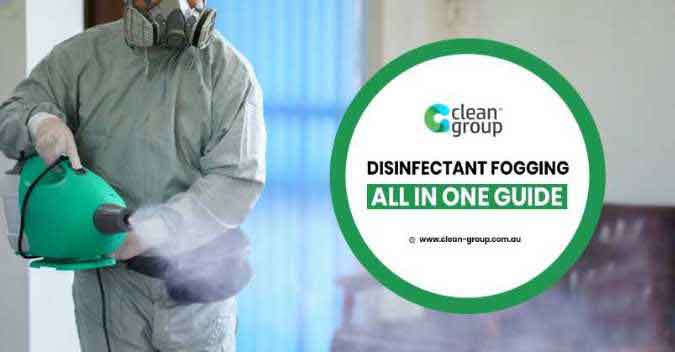There are many different disinfecting and cleaning methods against COVID-19, fogging/Spraying disinfectant is also one of them. Many commercial cleaners in Sydney introduce their techniques and approaches when it comes to cleaning, sanitising, and disinfecting businesses that hire them for the said disinfectant fogging service.
Which of these cleaning and disinfection methods are proven to be effective, and what sets them apart from one another? Allow me to walk you through the most popular techniques that are widely used in the commercial cleaning industry. Check out our “Everything You Need to Know About COVID-19 Cleaning Service” for more information.
Let me introduce to you the commercial disinfectant method. Read through with us as we unravel all the facts, advantages, and disadvantages of this technology.
Different countries all over the world responded to the Corona Virus by locking it down to break the infection chain. This course of action had affected many businesses. Many people had lost their jobs.
For those businesses who chose to remain open due to the pandemic, they will need to take all the precautionary cleaning and disinfection steps to assure that you are not just protecting your business, you are also protecting the people who work for you and your customers.
Cleaning helps to remove pathogens or significantly reduce their load on contaminated Corona Virus on different surfaces. The fogging solution must be prepared and used according to the manufacturer’s recommendation.
The fogging disinfectant solution should be applied to allow surfaces to remain wet and untouched for a period of time. Allowing the disinfectant to sit on the surface inactivate pathogens.
What is Fogging Disinfectant?
Fogging disinfectant technique uses electrostatic technology that introduces negatively-charged electrodes to the disinfectant. The chemical at room temperature is attracted to surfaces that allow 100 per cent surface coverage.
How Does Disinfectant Fogger Work?
Fogging method is proven to be more effective than the traditional wiping but can only provide 35 per cent protection. Apart from its efficacy, it is also more time-efficient and many of them come in a battery-operated machine.
What are the Benefits of Disinfectant Fogging?
- Reduces the spread of the CoronaVirus by
- Eradicate 99.9 per cent of harmful viruses like COVID 19, deadly germs and bacteria
- Better surface coverage
- Effectively disinfects touchpoints that are notorious for spreading germs, viruses, and bacteria.
- Safe and non-toxic
How Does Disinfectant Fogger Works?
Disinfectant fogger produces a mist that suspends in the air for a certain amount of time to kill bacteria and viruses. It kills pathogens in touchpoint areas. The fog coats the surfaces evenly, even those hard-to-reach points and odd-shaped objects.
This method is best for room decontamination.
How Does Disinfectant Fogger Work?
How Does Disinfectant Fogger Work?
Most commercial cleaning companies in Australia that offers Coronavirus cleaning in Sydney use the fogging method following these three simple steps:
1. Clean – the first stage involves deep cleaning. Initially, this is done to remove the biofilm that may be harbouring on the surface. This biofilm is the layer where germs and viruses linger. When cleaning, you must use a highly effective hospital-grade disinfectant as a cleaning agent.
There are lots of disinfectant solutions available in the market containing quaternary ammonium compounds that can kill 99 per cent of microorganisms while removing this biofilm, mould, and any organic residue on the surface. Disinfectant always observes dwell time for it to be effective.
2. Disinfect – After the deep cleaning and disinfection method, you can now use the electrostatic spray and load it with the same hospital-grade disinfectant that you used in step 1. or the usual hydrogen peroxide – one of the most common disinfection chemicals.
The electrostatic sprayer puts a charge into each droplet of disinfectant as it is sprayed. The process makes the droplet electrically more potent than the surface that it is treating. It envelops the target area giving it complete coverage.
Commercial cleaners do not need to wipe the surface after this process. They have to make sure that the chemical sits on the surface until it dries. Choose a hospital-grade disinfectant that is biodegradable and safe to use on any surface.
3. Protect – The final stage of this process is the same process as step 2. Only in this phase, instead of using a hospital-grade disinfectant, do you need to load your electrostatic sprayer with another chemical. This chemical is highly advanced, durable, and gives a persistent antimicrobial coating.
It is known to be a nano-coating that prevents the growth of viruses like COVID-19, bacteria, spores, and mould on every surface that is treated.
What Are The Chemicals That Can Be Used for Disinfection?
Since COVID-19 surfaced, many disinfectants claimed that they can kill microorganisms that pose serious health hazards to mankind. Different kinds of cleaning methods were put to test. Not all surfaces are treated the same when it comes to using disinfectants.
We all know that SARS COV2 are pathogens that suspend in the air for a certain number of days and we cannot be so sure about the disinfection process that the commercial cleaners in the area are introducing. We need to prove to ourselves that the areas are safe for ourselves, colleagues, customers, and family members.
Fogging is an acclaimed process that kills microorganisms effectively. This is a modern disinfection process that uses air and fog to cover surfaces with effective disinfectants.
But, what are you going to do if you cannot afford this process? What are the other alternative chemicals to use for room disinfection?
In dealing with SARS COV 2, you need to focus on contact surface disinfection. This means you need to sanitize the areas that are commonly touched or used.
It can be any surface like a desk, reception table, or stainless steel kitchen surface that is a common breeding ground for microorganisms. Here are some of the chemicals that can help you complete your infection control plan:
Hydrogen Peroxide – this type of chemical is commonly used for commercial and household bleach. It can be diluted with water to create a bleach solution that can be used for your disinfection needs. You can safely use this on any surface and area.
For the food industry, you can simply rinse it off with water for those surfaces that have food contact. On most surfaces, you can leave it to air dry after application.
Before you use hydrogen peroxide, we suggest you read the label first. Do not mix this chemical with any other cleaning disinfectants as it can produce harmful air.
UV Light – some studies show that this method is the most effective way of disinfection. UV light is known to disinfect almost all kinds of different surfaces. Unlike fogging, UV light does not need to use any harmful disinfectants.
It also does not leave any residue which means we do not need to neutralize any harmful disinfectant after the disinfection process. This method is highly recommended for disinfecting against SARS COV 2.
Sodium Hypochlorite – is one of the most effective chemicals being used as disinfectants. Studies have shown that it has higher efficacy ratings as compared to chlorine dioxide. This is also used in room disinfection and you can just let it sit in the air to get the best result.
Chlorine Dioxide – this is a yellowish-green gas that suspends in the air and dissolves in water. Apart from commercial disinfectants, this chemical is also used in water disinfection.
Preparation for Fogging Disinfectant Method
It would be best if you observed the following tips to achieve the best results of disinfectant Spraying/fogging:
- Clean the surfaces before cleaning and fogging disinfectant
- Put away all food and food materials from the surface
- Do not fog disinfectant on areas where food is stored or processed
- Turn off all fans and air conditioning units
- Close all doors and windows
- Vacate the room and leave it for at least two hours before letting the air out
- Allow the room to thoroughly air out before using it
- Do you need more information on COVID-19 Cleaning?

